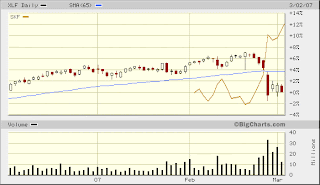ProShares has a slate of ultra ETFs that tracks eleven Dow Jones US indexes: Basic Materials, Consumer Goods, Consumer Services, Financials, Health Care, Real Estate, Industrials, Semiconductors, Oil & Gas, Technologies and Utilities. The ultra ETFs are meant to deliver 200% of the performance of the underlying index.
These ETFs come in two flavors: long and short (the short funds are often referred to as inverse). The short ETFs go up when the underlying index goes down. The long funds go up in concert with the underlying index.
If you are in the bear camp and believe we have further to go on the down side, this could be a good time to identify those sectors that are expected to be most under pressure in the coming weeks or months. In reviewing the charts this week, there was a pretty consistent pattern: big drops starting Tuesday, moving averages violated, etc. Those that looked most interesting to me include Financials, Industrials, Basic Materials and Technology. A good candidate out of this sub-group might be Financials. With the turmoil in the mortgage lending industry, especially in the sub-prime market, and the unwinding of the Japanese yen carry trade there are some negative factors setting up that could keep the Financials from bouncing back. In addition, if the current downturn becomes more extended it could reduce investment banking and brokerage revenues which have been strong lately. The following chart shows the Select Sector: Financial SPDR ETF (XLF) compared to its 65-day moving average and to the ProShares UltraShort Financials ETF (SKF).
Note that the 65-day MA for XLF has been clearly violated since the start of trading on Tuesday, 2/27. Note also that since 2/27, the UltraShort ETF has climbed over 10%. Of the sectors mentioned above, this chart is one of the most extreme.
The situations that have developed with the Select Sector: Technology SPDR (XLK) and the ProShares UltraShort Technology ETF (REW) and the Select Sector: Industrials SPDR (XLI) and the UltraShort Industrials (SIJ) look very, very similar to that of XLF and SKF.
The Select Sector: Basic Materials SPDR (XLB), however, has not broken down as badly as those mentoned above. Nevertheless, a bear could point to a number of troubling signs. Manufacturing in the U.S. has been struggling over the last few months and, as with technology companies, earnings forecasts are less than stellar. This would tend to impact Basic Materials as their customer base is saying they are not expecting business to be robust. In the case of Basic Materials, the chart is not so extreme as the one shown above for XLF. The 65-day MA has not yet been crossed but if it is, there would be time to catch the move early and potentially rack up a quick double-digit gain. Now might be the time to pay close attention to the ProShares UltraShort Basic Materials ETF (SMN).
If the Basic Materials trade looks good to you, you should also check out the situation developing with the iShares Dow Jones US Real Estate ETF (IYR) and the ProShares UltraShort Real Estate ETF (SRS). IYR had been trending strongly upward for several years until early in February when it finally began to weaken. This week's market drop just pushed it below its 65-day moving average and, with investors beginning to believe that real estate may not yet have seen the bottom, IYR could have further to go on the downside. As the following chart shows, this could be a good time to buy SRS.

For more information on the ProShares Funds click on the following links:
UltraShort Sector Funds and Ultra Sector Funds. These ETFs have only been available for about a month but they seem to have arrived just in time.

Comments
On the manufacturing note, I think trying to use protectionist tariffs, hand-outs, etc. to subsidize domestic manufacturing is a bad plan. I would rather have one of my children be a doctor or lawyer than work in a factory. Even though medicine and law are both the dreaded "service sector" sector jobs. ;-)
The fascination some have with maintaining domestic manufacturing at any cost is a holdover of mercantilist ideology imho.
Post a Comment